Chapter IV - The Sunny Colossus from Reflections on a Marine Venus (1953) by Lawrence Durrell. In this chapter Durrell tells the story leading to the creation of the Colossus of Rhodes in 280 BC. I’ve printed his written word verbatim and added images to accompany the story.
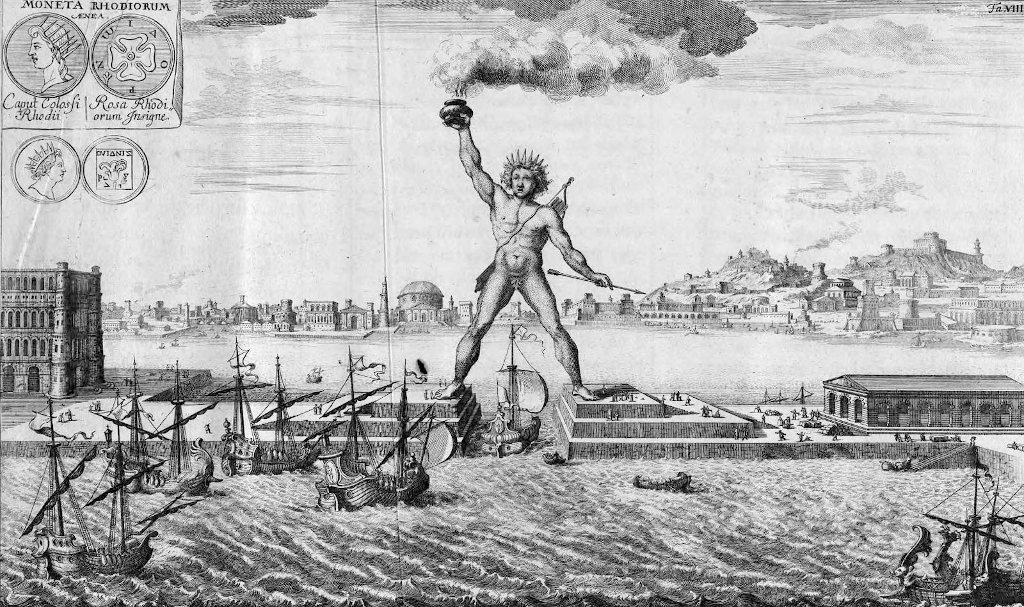
No companion to Rhodes would be complete without some reference to the island Colossus; and yet the subject cannot be touched upon without some reference to the siege out of which it was born, and to commemorate which it was designed.
The siege itself was a colossus in kind - so that to write of the statue of the Sun-God is to write of a colossus born of a colossus: of a peace born of a war.
Demetrius (surnamed Polyorcites or ‘Besieger’ after this epic attempt) was the direct author of the battles and the indirect author of the statue which commemorated them. The coins, Gideon tells me, show a fleshy face and a long sensitive nose, expressing clearly the mixture of coarseness and sensibility which one reads into his character as Diodorus described it. If the motto of Cleobolus was ’nothing in excess’; as a general he was considered a candidate for the honours of a second Alexander. He excelled in two qualities: science and lubricity. The inventive side of his genius came to full flower in the giant Helepolis - a third colossus - which so nearly overpowered the defences of the Rhodians. By the time he arrived off Rhodes in 305 BC he was already at the height of his powers as a soldier. He had thrashed Ptolemy and Cassander in summary fashion, and was a claimant for the empire which Alexander had left to fall to pieces after his death - an empire disintegrating under attacks of many claimants like a jelly-fish stranded on the beaches of Time.
The causes of the war were as follows: Antigonus, the father of Demetrius, had solicited an alliance with Rhodes against the Egyptian Ptolemy; this had been refused by the Rhodians on perfectly logical grounds. Their trade with Alexandria played too large a part in the economy of the island to be surrendered at the whim of a predatory old tyrant.
Rhodes, at this time, could afford to decide for herself. Her history, like that of England, might have been summed up in the words seapower, gold and neutrality. Both by geography and by temperament Rhodes lay just outside the storm-centres of trouble, and at every turn in her ancient history she took advantage of the fact. Where possible she reserved judgement and trusted in a fleet so powerful and skilful that it was famous in ancient times as the mythical colossus is in modern. The Rhodian sailor was famous for his courage and daring. They said of themselves ‘Ten Rhodians, ten ships’. For a great trading-station lying upon the main routes of the Aegean there was no other course. But here and there this enviable neutrality was broken. A choice was forced upon the peaceful Rhodians. Always they chose with an eye to the main chance: their one objective was to retain their independence. They did not always manage to do so: Artemisia, Cassius, are fateful names among those who broke the spell, and there were others.
So that the news of Demetrius’ arrival off the coast of Rhodes must have been received with mixed feelings. The Rhodians had sought no quarrel with him; indeed they continued to treat for peace right up to the moment of embarkation, and even voted a public statue to Antigonus in the hope that flattery would do what policy had failed to do; but it was in vain. Demetrius had been sent to teach them a lesson, and there is nothing to show that was loth to add yet another victory to his credit.
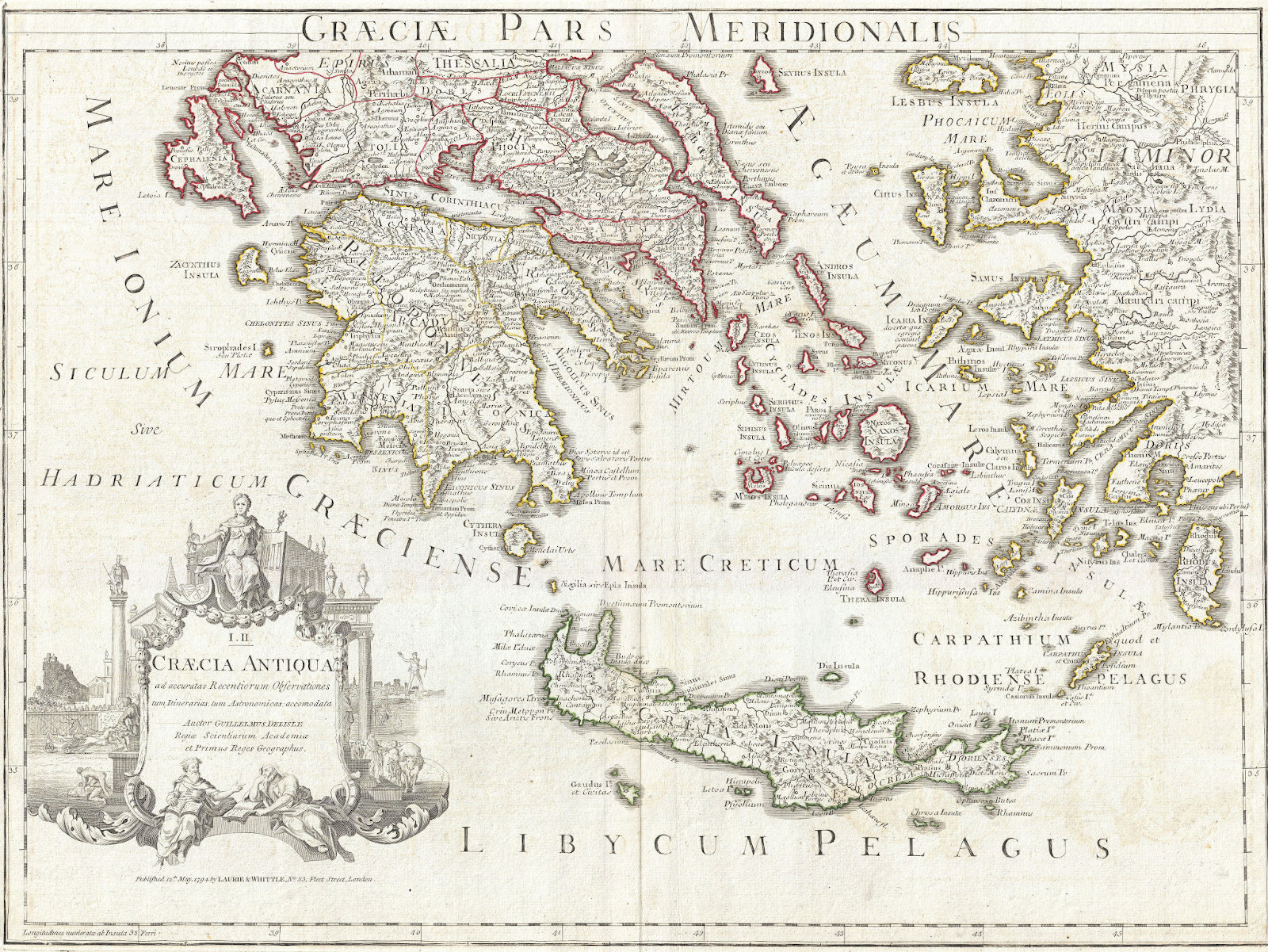
Rhodes, a Greek Island laying off the south coast of Asia Minor
The general was a thorough man; whether it was a question of debauchery or of scientific invention he gave himself wholly to it with admirable singleness of mind. His preparations for the siege left nothing to chance. Transported laboriously across those miles of sea his infantry numbered some 40,000 men. This figure excludes cavalry, sailors and engineers. The 170 troopships were convoyed by some 200 men-of-war of different sizes - some perhaps the fifteen bench galleys designed by Demetrius himself which struck such terror into the defenders of the coastal forts who watched them advance to attack. This great fleet, as it rolled across the blue carpet of the straits, under the Carian mountains, was followed, say the chroniclers, by countless ships of provision, and a horde of smaller vessels - vulture-boats - manned by itinerant adventurers who had followed the conqueror in the hope of chance spoil.
Standing on the flat roof-top of his house, wih the whole dazzling panorama of the town glittering in its marble amphitheatre below him, the Rhodian sentry who first caught a glimpse of this armada might be forgiven a momentary pang of fear as he watched it, contrasting the peaceful temples and colonnades of his capital below with that minatory horde of vessels forming up for an attack on the harbours. Across the still waters of the gulf he must have heard the creaking of tackle, the neighing of horses, and the hoarse voice commanding; the shrill squeaking of bosuns’ pipes and the crunch of oars as the galleys moved up the channel.
Yet to do the Rhodians justice their preparations were complete, and if their military leaders awaited the onslaught with comparative calm it was because they know how powerful the defences of the town were. Six thousand citizens and a thousand aliens within the city had been marshalled and armed; all who refused to bear arms had been expelled. The very slaves had been armed for the siege. Torr suggests that they alone must have added some 16,000 men to the standing garrison. Later there came reinforcements from Crete and from Egypt, for throughout the siege the superior naval skill of the Rhodians enabled them to keep the sea-routes open to the south and west. A sympathetic Crete pushed a reinforcement of 150 men into the town, while Egypt sent 2,000 to help her ally. It was a case of some twenty-five thousand men besieged by roughly twice that number. If Demetrius was a thorough man the Rhodians showed themselves no less so; their defences were strengthened as much as possible, the armed slaves were promised citizenship if they fought well, and the fleet was ordered to stand by for action. Meanwhile such citizens as were not standing to arms were busied by the construction of catapults and balistas to mount along the parapets of the town-wall. While Demitrus’ scouts worked their way slowly round the walls, cutting down trees to make palisades and destroying any suburban houses they came across, the Rhodian fleet made a sudden sortie against some provision-ships which had arrived for Demetrius. These they captured and brought into harbour together with a number of captives from them. This was a rich gain in ransoms.
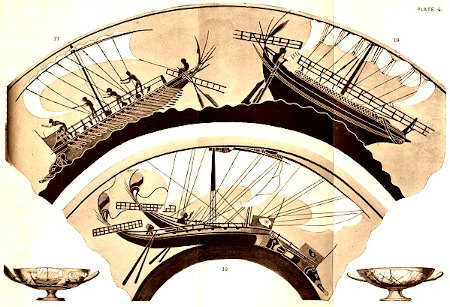
Illustration adapted from Cecil Torr, Ancient Ships, 1895. (Top) war ship and merchant ship, about 500 BC. (Bottom) two war ships, about 500 BC. From painted vases found at Vulci in Etruria. Source
Demetrius, however, was taking his time. He had decided upon an assault to be launched against the main harbour - indeed there were no other anchorages of any use to him along the shovel-shaped end of the island; and if he failed to take the port he would be unable to refit and refuel his forces. He had built two great tortoises - floating pent-houses strong enough to carry assault-crews, archers, and a great armament of catapults - and these he proposed to float into the mouth of the harbour. He had also constructed two great towers of wood which would enable him to overshoot and enfilade the towers guarding the moles. These were also contrived upon a float. The whole of this uncouth equipment was assembled and the signal to engage had been given when a storm sprang up, and the whole battle-order disturbed. During the day the sea lashed the siege-craft of Demetrius until it seemed that he would lose everything; but as night fell a calm came over everything. It was an opportune moment for an attack, and he took advantage of it, with qualified success. Four hundred men got ashore and captured a small eminence about 500 paces from the wall, where they dug themselves in.
Early next morning rams were brought up and the signal for the general attack was given to the sound of trumpets. A series of violent exchanges began which were to last the whole of that day. Several breaches were opened in the wall guarded the mole, but the Rhodians resisted with tenacity and held the enemy off. At nightfall Demetrius withdrew his main forces for refitting, and while he was doing so the Rhodian fleet, under cover of darkness, tried to float fire-ships amongst the enemy units. At first they were unsuccessful, but later they did considerable damage with their sudden sallies from the port. But the major action of the siege was yet to be fought. Demetrius tried several times to force the harbour; a series of skilful and exhausting actions were fought in the breaches of the mole. Giant catapults mounted on the hillock he had captured pounded the city-wall until it rocked under the great bullets of stone. It should be remembered that the missile engines of these early times had been developed into formidable instruments of offence and defence. They could throw from seventy pounds up to six hundred pounds of stones; or launch darts from six to twelve feet long. Archimedes at the siege of Syracuse constructed some which could life and throw no less than eighteen hundred pounds of stone. The ranges offered considerable variation according to the size of the machine, but the larger ones size hundred yards was the average for direct fire and a thousand yards for curving fire.
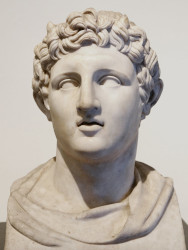
Demetrius
But to return to Demetrius, his picked infantry tried escalade after escalade only to be forced back from the parapet by the defenders. It became obvious that an attack on the harbour would fail; it became obvious moreover that a blockade was impossible in view of the Rhodian naval superiority. Demetrius withdrew temporarily and refitted his fleet for yet another attempt on the harbour; he wanted to be quite sure that it was impregnable before adopting other methods or objectives. His second assault met with the same fate - due once more to weather and to the Rhodian navy, which made a sally when it was least expected and damaged many of his ships. There seemed to be nothing for it but to construct a Helepolis and let it loose upon the Rhodians. Once more the forces of Demetrius were stood easy while the general indulged his scientific turn in supervising this colossus among siege-engines. Meanwhile the Rhodians had recovered some of their usual fire; their nimble fleet harassed his communications, and in one sortie carried off a number of rich presents, pictures, and a letter from Demetrius’ wife Phila - the whole of which, including the letter, they sent to Ptolemy of Egypt: an act which infuriated Demetrius beyond endurance. To add to his troubles Rhodian infantry made sorties during the night and set fire to some of his batteries. Meanwhile, however, the giant Helepolis was well under way. Diodorus describes it lovingly - almost rubbing his hands along its massive sides. It must have been an awe-inspiring machine to look at.
The Helepolis was a moving tower on wheels of oak. The base of it was square and the sides sloped inwards. There has been some argument about the original size of it. Diodorus says it was 150 feet high by 75 feet broad. Much later Vitruvius calculated its weight at 125 tons but this may have been an academic exercise in mathematics only. Nine stories high, it towered above the Rhodian walls. It was replete with catapults, grappling irons, and drawbridges which could disgorge infantry upon the parapets they had not succeeded in scaling. It groaned and creaked as it moved, but it worked - and what is more astonishing, it took an operational crew of three thousand four hundred men to propel it. In common with most of the siege-weapons of the day it was given a tough outer skin of plaited osiers or hides. The top floor was a nest for archers, but the floor beneath carried tanks of water serviced by forced pumps with hoses made from the intestines of cattle. On either side of the Helepolis were built supporting tortoises with rams, and covered gallery for the sappers to work in. It is not hard to imagine what the Rhodians felt as they saw this great siege-piece assembled and dragged within assault-distance from their walls. They must have seen the engineers testing the monster, testing its great battering rams and drawbridges before it was dragged towards the walls of the city. Indeed they had made frantic attempts to impede the work of construction, but in vain. Desultory sorties had not been undertaken in sufficient force; burning arrows had been quenched by the sappers; while industrious mine-works had been met with counter-mines which advanced the ends of neither party.
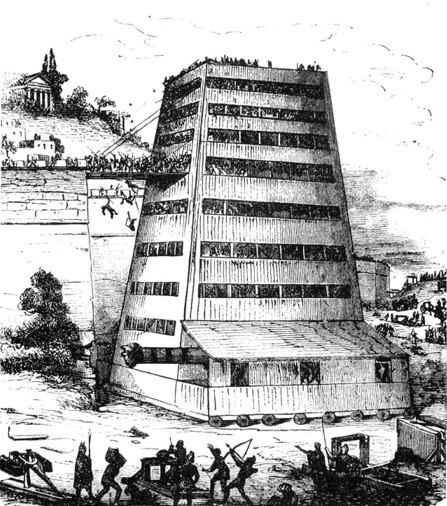
Hopes had been raised by the arrival of a Cnidian embassy to Demetrius which had been sent to offer mediation. Demetrius however refused to countenance any further talk. The Helepolis was his answer. he had moved it into position for the assault, noting with his professional eye how little effect the hail of stone-shot had upon it. Their morale was high. Abundant food supplies had reached them from their allies. The first victory had been theirs - a good augury; while Demetrius had failed by sea twice, and had recently failed to buy his victory with a bribe. His agents had approached Athenagoras, captain of the Rhodian guard, with the offer of a vast sum of money in exchange for his complicity; the offer was promptly announced to the Rhodians, who voted Athenagoras a gold chaplet and five talents for his honesty. Since he himself was not a Rhodian, but of Miletos, and in command of Egyptian mercenaries, the augury was a good one. To bind the resolve of the besieged still more firmly the Rhodians announced that those citizens who fell in action would be buried at public cost, their parents and dependents maintained out of treasury funds, and their daughters dowered by the state when they married. Their sons, added the decree, would be crowned in full armour in the Theatre at the Festival of Dionysos, when they had reached manhood. It was a sound stroke of policy. Emboldened by these announcements no less than by the sudden arrival of supplies, the Rhodians manned their walls and prepared to defend them or die.
It was perhaps during this part of the siege that the attacking forces broke through a part of the wall and took back with them news that there, in a walled garden, they had seen the painter Protogenes painting away with perfect calm in all the din of assault and counter-assault. His famous paintings of Ialysos as a hunter was occupying his mind to the exclusion of anything else. A deputation of Rhodian citizens had already pleaded with Demetrius to respect this work and guarantee its safety. According to Pliny’s anecdote, Demetrius asked Protogenes to present himself at his headquarters, and when he did so he asked him how he could work away at his painting while the fate of the town hung in the balance. The painter replied: ‘I am aware that you are making war upon people and not upon the arts.’ There is just the faintest flavour of flattery about it; enough at any rate to win over Demetrius, who assigned the painter a special bodyguard and ordered that he was not to be molested.
At the first rush the great Helepolis knocked down a tower and carried away a vital section of wall. Troops poured into the breach like ants and a ferocious melee took place across the gap. For a time the pendulum seemed to swing toward the attackers, but the Rhodian line held, though it was strained to cracking point. The battle lasted all day, and when night fell Demetrius saw that his troops had not managed to force an entry into the town. Worse still, the Helepolis was damaged, and would need to be repaired. Once more he was obliged to call a halt. Diodorus does not record the language the general used as he surveyed the stricken engine, mounted upon the rubble of the blood-stained wall it had breached, choked with dead bodies and ammunition. Whatever he had to say must have been sultry in the extreme. Meanwhile the Rhodians were hard at work, taking advantage of the lull to dig in behind the great half-moon of the fallen wall. Siege-pieces were renewed and refitted. A scratch crew went up and towed back the Helepolis to a place of safety where the engineers could work on it untroubled by the whistle of arrows and pointed shot from the walls which still swarmed with defenders. It was beginning to develope into an ugly stalemate. No doubt the Athenian embassy which arrived at this juncture took occasion to point this out; yet even their offers of meditation fell upon deaf ears. Both parties stood firm. The Helepolis was repaired and moved slowly back into position opposite that tantalising breach in the city wall. Demetrius was like some great cat hypnotised by a mouse-hole too small to admit more than a single paw. The faded arguments of the ambassadors hardly grazed his intolerable restless resolve to attack and conquer the city.
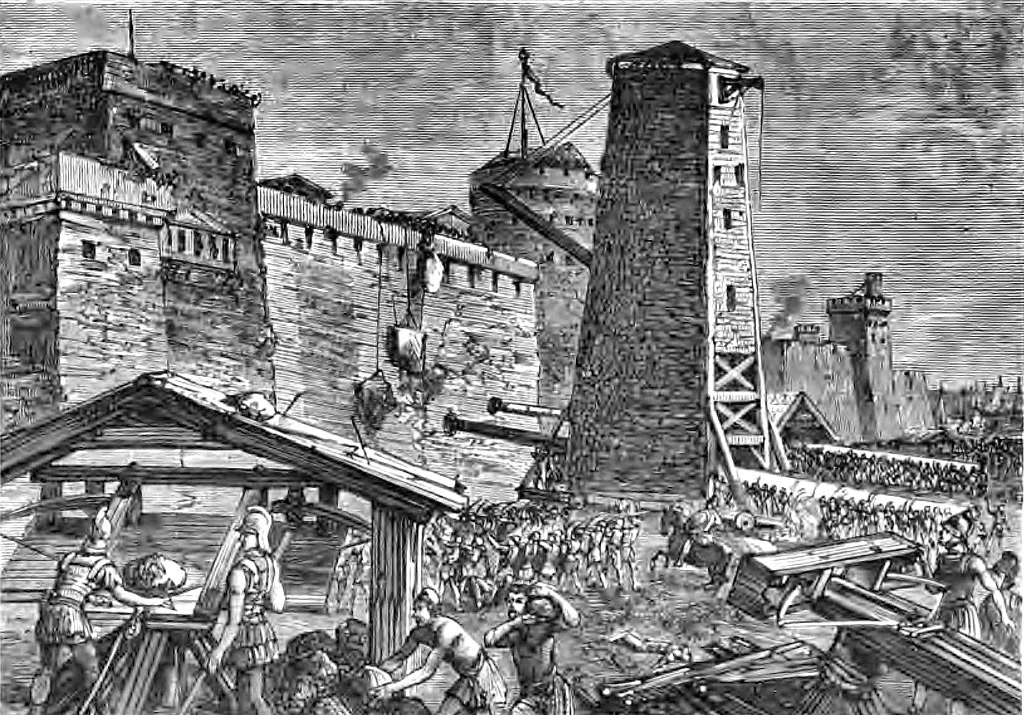
Now for a delightful piece of Greek jobbery. Some time before the siege a certain Callias of Arados had arrived in Rhodes and set himself up as an engineer specialising in siege-pieces. One of his designs captured the popular imagination. He proposed to mount a crane on the walls which, he said, would be strong enough to pick up a common Helepolis in its grab and lift it over into the city at one blow. The idea was charming though mechanically unsound. Yet one can see why it should have made him so popular … A Helepolis suddenly lifted into the air, with its infantry tossed out like weevils from a broken biscuit, its drawbridges flapping loose, its water-tanks pouring … Such a crane as Callias could design would be an even more remarkable machine than the Helepolis itself: so at least they told one another. Callias was delighted at the warm reception the Rhodians gave his idea. He accepted without hesitation the post of state architect to Rhodes, a post then held by one Diognetus. The crane was build according to specifications and mounted. But alas, it was quite incapable of fulfilling the demands Callias made upon it; not only did it not drag the Helepolis over the wall. It failed even to lift it. The crash of the falling wall, and the cloud of dust which hung in the air where once the tower stood as a strong-point must have brought the truth of the matter home rather forcibly to all concerned.
The Rhodian fathers went hotfoot to the home of Diognetus. They wanted him back as state architect. But Diognetus was in a huff - one of those unfathomable Greek huffs which have been handed down unchanged into modern times, and which every traveller must learn, sooner or later, to deal with. Deeply wounded in his pride, burning with that all-suffering resentment which today lights up his descendants whenever their slightest whim is not gratified, he refused to consider the requests of his fellow citizens. He shrugged away tears and entreaties of the greybeards. He ate fruit and raised his eyebrows to indicate with absolute finality that he had long ago washed his hands of the whole business. People foolish enough to trust charlatans, etc … The pattern of the conversation is perfectly clear. It is a conversation which takes place daily in Greece today. Nothing less than a full-scale procession of ingenuous youths and maidens, bearing branches, would soothe an amour-propre so deeply wounded. Diognetus wanted the Rhodians to ask nicely. Thus in the midst of the siege a procession was organised, led by moaning priests from the templates, and followed up by wailing choirs of maidens and youths bearing branches of laurel. ‘Help us’ they cried; and Diognetus watching the extent of the procession and hearing the heart-felt wails of the suppliants, condescended to accept his former post once more. A wave of relief swept over everyone. Diognetus was back at work. The procession had finally won him over. The vindicated state-architect made his way back to the walls and gazed out across the shattered suburbs of the city to where the great machine stood, waiting for the signal to be given before it advanced toward the breach. Rhodian infantry were still busy digging in around the half-moon of fallen masonry. A sickening suspense - white clouds of dust from broken statuary and crumbling walls that eddied in the still summer air - hung over everything. The enemy had re-formed. Fifteen hundred picked men went to force the breach by night and effect an entry; while the signal for the general assault was given they were to establish themselves inside the city, based upon the theatre, and there to hold out until the Helepolis widened the breach, and the rest of the infantry could be pushed in to reinforce them. The plan appeared to work. The entry was made, the theatre taken, and for a while the garrison was thrown into a panic by the knowledge that the enemy had gained a foothold inside the walls. But the Rhodians recovered their resolution far more quickly than Demetrius had imagined possible; the area round the theatre was sealed off by the best of the Rhodian infantry and the Egyptian mercenaries were thrown into the battle against the enemy. Fires raged all night long, and fierce hand to hand combats took place. Meanwhile the lumbering Helepolis had met with a second and final disaster, thanks to the intelligence of Diognetus. There are two versions of the story, of which the latter is by far the prettier. The first states that a long mineshaft was opened along the projected line of advance of the Helepolis; the second states that Diognetus skilfully diverted the sewage of the town into the path of the monster, and that it stuck, ankle-deep, the quag and could not be budged. This was most disheartening. It ruined Demetrius’ chances of pushing his infantry into the town to support the shock-troops. The latter by this time were much reduced by the Rhodian attack, and by the middle of next day, were forced to surrender. It was the end of the attack.
But while the battle was at its height Demetrius had received a most urgent message from his father ordering him to conclude a truce with the Rhodians as soon as possible and to return. Antigonus had other problems on his mind. At the same moment - most opportunely this time, for their arrival enabled Demetrius to save his face - came a deputation from the Aetolians, asking permissions to mediate. Demetrius accepted the offer on condition that the terms were acceptable - and ambassadors were despatched to the city to arrange them. The Rhodians, too, by this time were disposed to treat; the latest battle had been for them an extremely narrow escape from defeat - and it had brought home most forcibly the penalties of war which a truce might prevent them from suffering. They were anxious to accept the terms of the treaty - and indeed its articles were not politically unfavourable to the future of Rhodes. In exchange for an alliance with Antigonus against any enemy save Ptolemy they were allowed to keep their freedom. A hundred hostages were to be held by Demetrius against this assurance. Once the articles were accepted the besiegers would decamp and not trouble the island more. It was an honourable enough compromise, and the Rhodians rejoined in it; Diognetus enjoyed his share of the honours, while the Helepolis was dragged into the city and dedicated to the people.
Walking over the ruined suburbs of the great city with the little knot of treaty-makers Demetrius found himself wondering what he could do with all the useless, half-smashed equipment which littered the ground. Magnanimity was not entirely foreign to his nature. He admired the stubborn way the Rhodians had defended themselves against him. Was there nothing he could do to set a seal upon this contagious goodwill which, now the siege was ended, infected everyone, friend and enemy alike? On an impulse he handed over all the equipment he had brought with him to the Rhodian people; he asked that they should sell it, and from the proceeds of the sale erect a statue to commemorate a siege so notable in the history of their times. It was a gesture quite in keeping with his character, and was accepted in that spirit. So it was that the statue of the Sun God was born. Only a colossus could adequately bear witness to the greatness of the siege, the size of the engines used, the heroism of both sides - and the odd impulses of generosity which sometimes stir the hearts of tyrants.
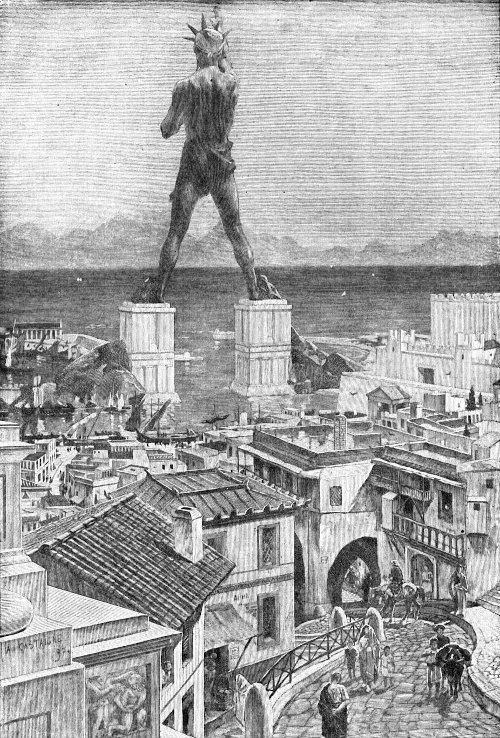
The statue was undertaken by Chares of Lindos, a pupil of Lysippus. It cost three hundred talents which resulted from the sale of the siege-train which Demetrius had left behind him in the spring of 304 BC. Moreover it cost the sculptor twelve years of his life to cast and mount. Its height is variously given but was most likely 105 feet. A prodigious statue, one would think, to work and mount with the available equipment of the day. Pliny does not state how large a staff of pupils and workmen was retained by the sculptor, nor what sort of scaffolding and machinery was necessary to set the state up. He does say, however, that even when it had fallen down and become a total wreck it was still a prodigy. Its very finger larger than many of the statues in that city of colossi. The gaping rents in it, the cavities and fractures, revealed the masses of rock and iron which had gone to building an armature heavy enough to support the construction.
Pliny’s account is most circumstantial. Writing three hundred years after the earthquake which overthrew the statue, he was still in time to see the ruins as they lay upon the ground. For those who enjoy scholastic ambiguity and polemic however there is an inscription attributed to a certain Simonides which claims the work as executed by Laches of Lindos. The portly Sextus Empiricus has offered us an intellectual compromise on this burning question by producing a not unlikely story that Chares, the designer of the state, having offered his estimates for the work was told to double its size; this he did, but as he had already spent the money given him he took his own life, and left Laches to carry on the work. The statue, then, took twelve years to build, and enjoyed a life of fifty-six years before the earthquake of 227 BC overturned it.
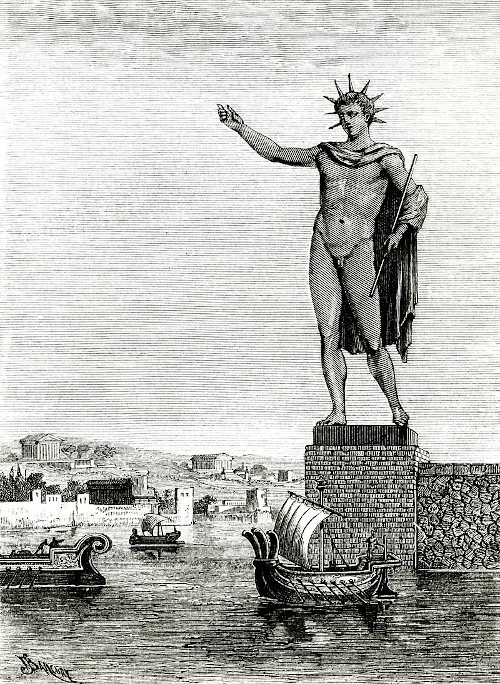
The site of the Colossus has never been determined with any accuracy, nor has the pose been described for us by reliable eye-witnesses. Argument over possible sites and poses is likely to go on until the next earthquake, in which presumably the whole island of Rhodes will sink into the sea and leave behind it legends as tenuous as those which make up the myth of Atlantis. At any rate the story that it stood straddling the harbour with its huge legs is a medieval confection. And here it must be confessed that the greater part of the Colossus’ fame dates from the Middle Ages. ‘In ancient times it attracted little notice; it did not rank among the masterpieces of Greek sculpture, and in size it was rivalled by earlier and even surpassed by later statues.’ It was, it is true, placed in the catalogue of the Seven Wonders - and to this, no doubt, it owed its great celebrity during the Middle Ages.
For fifty-six years the Colossus stood as a tribute to the magnitude of the siege, and then came of of those sudden earthquakes to which much of the Aegean area is still subject. The town was shaken to its foundations. The templates, the arches, the statues - in the space of a day they had been swallowed up. And in the forest of falling statuary the Colossus was only one of a number of casualties sustained on that memorable day in 227 BC. An inscription recently unearthed by Sand positively forbids the Rhodians to add another statue to the temple of Aesculapius. The earthquake must have more than regulated such questions of votive overcrowding; the echo of tumbling statues and falling public buildings reached every corner of the civilized world. For nine centuries the figure of the Sun-God was to lie prostrate in the town it had adorned. It was not until the VIIth century that the shattered remains of the piece were knocked down to a Jew from Syria and transported in camel-loads to the Middle East for boiling down. Presumably the statue was formed once more into implements for a fresh war. This is the kind of inverted poetry by which we live. At any rate the amount of the successful bid was not been recorded; the Jew probably got it cheap; the story goes that it took him 900 camels to load and carry it off. ‘The twenty tons of metal’ says Torr coldly, ‘would not, however, load more than 90 camels.’

It says something for the veneration and love with which Rhodes was regarded in the ancient world that though the city was razed to the ground the island’s allies at once began to send presents of money and food. Ptolemy, that perspicacious hunter of fine books, was deeply moved by the disaster, while the Kings of many other neighbouring states bestirred themselves to help the Rhodians. Treasure flowed in - the greater part of which, no doubt, was intended to help with the resurrection of the Sun-God. The Rhodians themselves were anxious to set up the great statue once more, but a curious fact prevented them from doing so. The Oracle of Delphi pronounced against the idea. Worse evils might follow, it said, if the Sun-God were to be set up again. The Rhodians, recalling that hubris always carries its ugly reward, desisted.
A good deal of ink has been shed in an attempt to elucidate the problem. Why should the oracle of Delphi, the centre of Apollo-worship, transmit so unfavourable an omen to stricken Rhodes? Insinuating tongues have suggested that the Rhodians found better uses for the donations of neighbouring states, and even that they came to some underground arrangement with the priests of the oracle in order to provoke such an announcement and be free from the irksome necessity of rebuilding the Colossus. It is also hinted … but here again the evidence becomes, in Torr’s phrase, ‘flimsy,’ and in Gideon’s ‘rather thin on top.’ I must leave the reader to worry his own way through the alleys and loop-holes of the argument. As for ourselves, we have spent days arguing about it; afternoons diving in the harbour for fragments of it (in pursuit of some mad theory of Gideon’s that it was situated upon the easterly mole, and that some of its shattered fragments must have surely fallen into the water): and now the historical impact of its name is mixed with memories of pure sunlight, these dancing summer days passed in idle friendship and humour by the maned Aegean. Who could ask for better?

